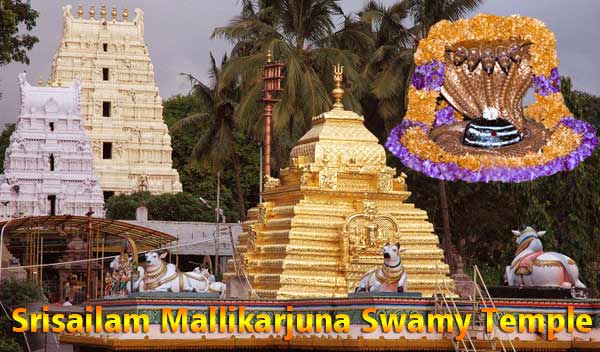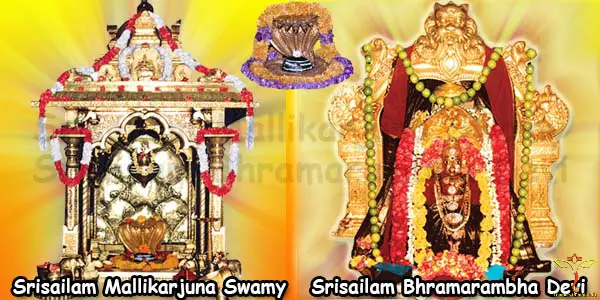From time immemorial, Srisailam has played a leading role in our religious, cultural and social history.
As per pre-historic studies, the history of Srisailam dates back to about 30,000-40,000 years ago. Stone tools of very ancient times have been found in abundance at different locations of Srisailam. The epigraphic studies have revealed that the history of Srisailam begins with the Satavahanas who were regarded as the first builders of empire in South India and also the first rulers of Andhra Desa.
The earliest known historical reference of Srisailam hill can be found in Pulumavi’s Nasik inscription belonging to 2nd Century A.D. Malla Satakarani was the name of an early ruler of the Satavahanas, who got his name after ‘Mallanna’, the deity of Srisailam. The Ikshavakus of AD 200-300 ruled their kingdom from their capital at Vijayapuri, which was about 50 Km from Srisailam and hence this Kshetram must have got their support

The Vishnukundis (AD 375-612) worshipped God Sriparvatha Swamy who was one and the same Mallikarjuna Swamy, the presiding deity of Srisailam Temple. Most of their inscriptions contain the phrase “Bhagavat Sriparvatha Swamy Padanudhyatanam”.
According to the Telagunda inscriptions of Kadamba Santi Varma, the Srisailam region was initially a part of the Pallava Kingdom (AD 248-575) and afterward formed the first independent domain of Kadambas (AD 340-450).
Some of the inscriptions and the architectural features of the Srisailam temple complex confirm the presence of Chalukyas (AD 624-848). There are also evidence regarding the contributions of Kakatiyas (AD 953-1323) for the development of the temple. It has been found that they had taken several measures during their period to regulate the temple management. During the rule of Kakatiya Prathaparudra, which dates back to 1313 AD, there was mention about the gift of 70 villages to Srisailam temple made from time to time by several emperors, kings etc., which was accomplished in a proper manner for the maintenance of the temple. It is said that the vimana gopuram of Mallikarjuna Garbhalayam was constructed by Mailamadevi, sister of Ganapathideva.
The period of Reddi Kings (AD 1325-1448) is believed to be the Golden Age of Srisailam because all rulers of this dynasty had done their best services for the temple. It was Prolaya Vema Reddy, the Reddi King who constructed the stepped pathway to Srisailam Bhramarambha Mallikharjuna Swamy Temple and Pathalaganga. Veerasiro Mandapam was constructed by Anavema Reddi. In this mandapam, the Veerasaiva devotees cut off their hands and other limbs to express their devotion to God, which was a practice known as Veeracharam.
The flight of steps at Jatararevu, on the way from Umamaheswaram to Srisailam, was constructed by the Velama Chiefs.

Vijayanagara Rulers (AD 1336-1678) were responsible for undertaking major contributions and renovations at Srisailam. The Mukhamandapam of Mallikarjuna Temple was constructed by the Second Harihararaya of the Vijayanagara Empire and he also built a Gopuram on the Southern side of the temple complex. In 1516 AD Srikrishnadevaraya visited Srisailam temple on his return journey after a war with Gajapathis and he constructed Salumandaps on both sides of the car street. He also constructed the Rajagopuram of the temple. After the decline of Vijayanagara’s rule, Srisailam lost its glory.
The great Maratha King Chatrapathi Sivaji visited Srisailam in the year 1674 AD. He re-established the festivals of the temple under the security of his officers and undertook some renovation work. The construction of the north gopuram of the temple was initiated by him.
Later on, the Moghal Emperors invaded and conquered this region and this place was given as Jagir to Nawabs of Kurnool.
After the descent of Moghal Emperors, Srisailam became under the control of the Nizam of Hyderabad. When the Nizam conceded Kurnool District to the British East India Company in 1800 AD, Major Manro took possession of the District and handed over its management to the District Court authorities.
In 1929 the British Government established a committee for the management of Srisailam Bhramarambha Mallikharjuna Swamy Temple.
In 1949 the Endowments Department took control of the temple and the temple attained its past glory after it became accessible by road during the year 1956.
